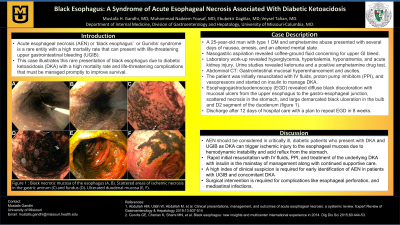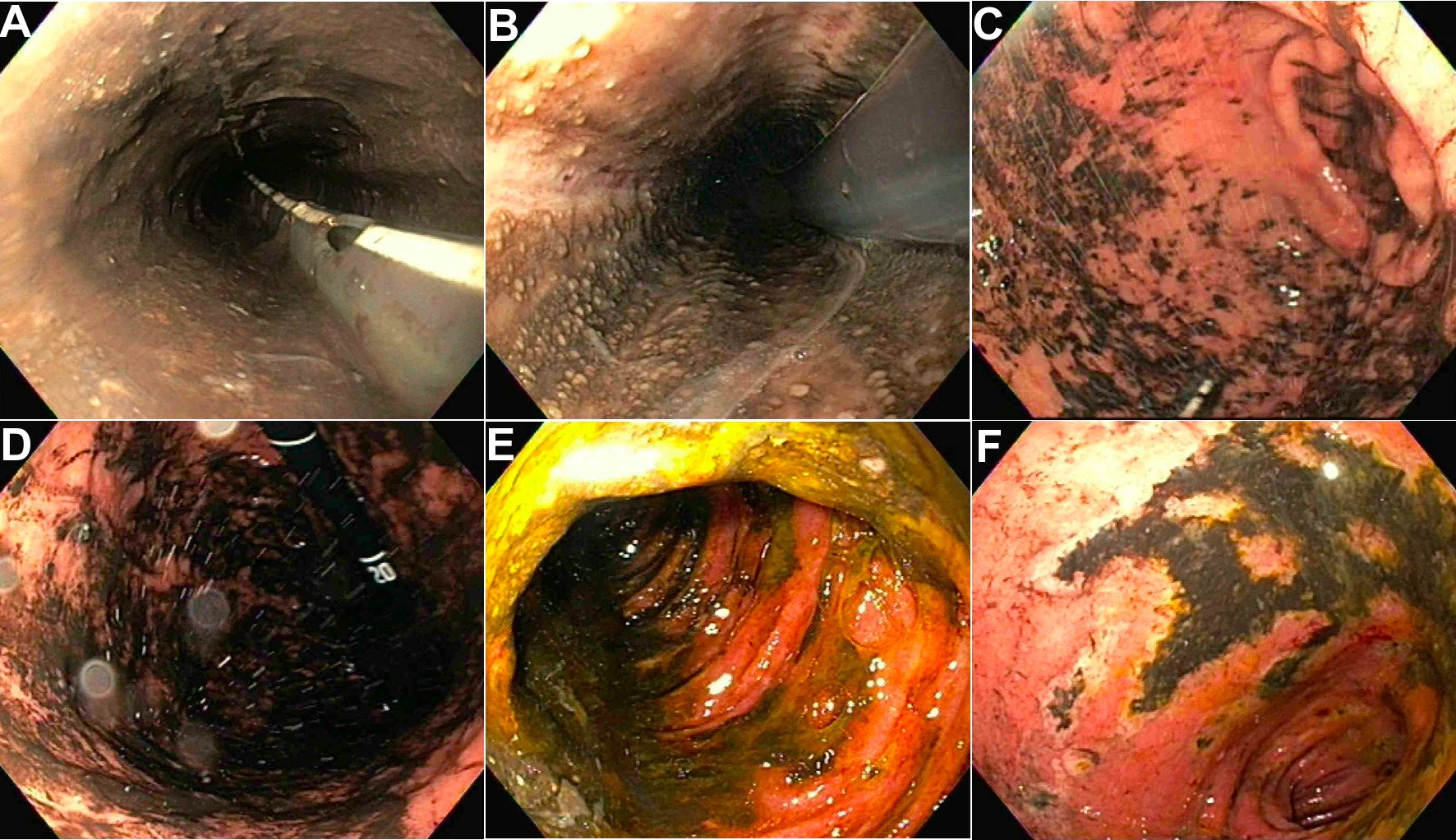Back


Poster Session B - Monday Morning
Category: Esophagus
B0244 - Black Esophagus: A Syndrome of Acute Esophageal Necrosis Associated With Diabetic Ketoacidosis
Monday, October 24, 2022
10:00 AM – 12:00 PM ET
Location: Crown Ballroom

Has Audio

Mustafa H. Gandhi, MD
University of Missouri-Columbia
Columbia, MO
Presenting Author(s)
Mustafa H. Gandhi, MD1, Muhammad Nadeem Yousaf, MD2, Ebubekir Daglilar, MD2, Tahan Veysel, MD2
1University of Missouri-Columbia, Columbia, MO; 2University of Missouri, Columbia, MO
Introduction: Acute esophageal necrosis (AEN) also known as ‘black esophagus’ and Gurvitis’ syndrome is a rare entity with a high mortality rate that can present with life-threatening upper gastrointestinal bleeding (UGIB). We aim to illustrate this rare presentation of diabetic ketoacidosis which has a high mortality rate and life-threatening complications that must be managed promptly to improve survival.
Case Description/Methods: A 25-year-old man with insulin-dependent type I DM and amphetamine use disorder was brought to the ER after several days of nausea, emesis, and non-adherence to insulin therapy causing obtundation. Nasogastric aspiration revealed coffee-ground fluid. Laboratory work-up was significant for hyperglycemia, hyperkalemia, hyperglycemia-induced hyponatremia, and acute kidney injury. Urine analysis and drug screen were positive for ketones (20 mg/dL) and amphetamines respectively. An abdominal CT scan showed gastrointestinal mucosal hyperenhancement and ascites. After resuscitation with IV fluids, insulin drip, proton pump inhibitor (PPI), and vasopressors, an esophagogastroduodenoscopy (EGD) was performed which revealed diffuse black discoloration, mucosal ulcers starting from the upper esophagus extending to the gastro-esophageal junction, scattered areas of necrosis in the stomach, as well as large black demarcated ulcers in the bulb and D2 segment of the duodenum (figure 1). With continued supportive care, he was discharged after 12 days of hospital care without any further complications and a plan to repeat EGD in 8 weeks.
Discussion: AEN should be considered in critically ill, diabetic patients who present with DKA and UGIB as DKA can trigger ischemic injury to the esophageal mucosa due to hemodynamic instability and acid reflux from the stomach. Rapid initial resuscitation with IV fluids, gastric acid suppression, and treatment of the underlying diabetic ketoacidosis with insulin is the mainstay of management along with continued supportive care. A high index of clinical suspicion is required for the early identification and management of AEN. Surgical intervention is required for patients with AEN complications such as esophageal perforation, and mediastinal infections.

Disclosures:
Mustafa H. Gandhi, MD1, Muhammad Nadeem Yousaf, MD2, Ebubekir Daglilar, MD2, Tahan Veysel, MD2. B0244 - Black Esophagus: A Syndrome of Acute Esophageal Necrosis Associated With Diabetic Ketoacidosis, ACG 2022 Annual Scientific Meeting Abstracts. Charlotte, NC: American College of Gastroenterology.
1University of Missouri-Columbia, Columbia, MO; 2University of Missouri, Columbia, MO
Introduction: Acute esophageal necrosis (AEN) also known as ‘black esophagus’ and Gurvitis’ syndrome is a rare entity with a high mortality rate that can present with life-threatening upper gastrointestinal bleeding (UGIB). We aim to illustrate this rare presentation of diabetic ketoacidosis which has a high mortality rate and life-threatening complications that must be managed promptly to improve survival.
Case Description/Methods: A 25-year-old man with insulin-dependent type I DM and amphetamine use disorder was brought to the ER after several days of nausea, emesis, and non-adherence to insulin therapy causing obtundation. Nasogastric aspiration revealed coffee-ground fluid. Laboratory work-up was significant for hyperglycemia, hyperkalemia, hyperglycemia-induced hyponatremia, and acute kidney injury. Urine analysis and drug screen were positive for ketones (20 mg/dL) and amphetamines respectively. An abdominal CT scan showed gastrointestinal mucosal hyperenhancement and ascites. After resuscitation with IV fluids, insulin drip, proton pump inhibitor (PPI), and vasopressors, an esophagogastroduodenoscopy (EGD) was performed which revealed diffuse black discoloration, mucosal ulcers starting from the upper esophagus extending to the gastro-esophageal junction, scattered areas of necrosis in the stomach, as well as large black demarcated ulcers in the bulb and D2 segment of the duodenum (figure 1). With continued supportive care, he was discharged after 12 days of hospital care without any further complications and a plan to repeat EGD in 8 weeks.
Discussion: AEN should be considered in critically ill, diabetic patients who present with DKA and UGIB as DKA can trigger ischemic injury to the esophageal mucosa due to hemodynamic instability and acid reflux from the stomach. Rapid initial resuscitation with IV fluids, gastric acid suppression, and treatment of the underlying diabetic ketoacidosis with insulin is the mainstay of management along with continued supportive care. A high index of clinical suspicion is required for the early identification and management of AEN. Surgical intervention is required for patients with AEN complications such as esophageal perforation, and mediastinal infections.

Figure: Black necrotic mucosa of the esophagus (A, B). Scattered areas of ischemic necrosis in the gastric antrum (C) and fundus (D). Ulcerated duodenal mucosa (E, F).
Disclosures:
Mustafa Gandhi indicated no relevant financial relationships.
Muhammad Nadeem Yousaf indicated no relevant financial relationships.
Ebubekir Daglilar indicated no relevant financial relationships.
Tahan Veysel indicated no relevant financial relationships.
Tahan Veysel — NO DISCLOSURE DATA.
Mustafa H. Gandhi, MD1, Muhammad Nadeem Yousaf, MD2, Ebubekir Daglilar, MD2, Tahan Veysel, MD2. B0244 - Black Esophagus: A Syndrome of Acute Esophageal Necrosis Associated With Diabetic Ketoacidosis, ACG 2022 Annual Scientific Meeting Abstracts. Charlotte, NC: American College of Gastroenterology.
